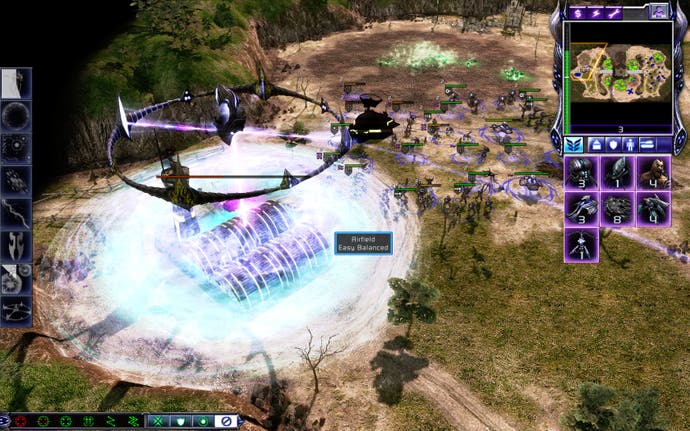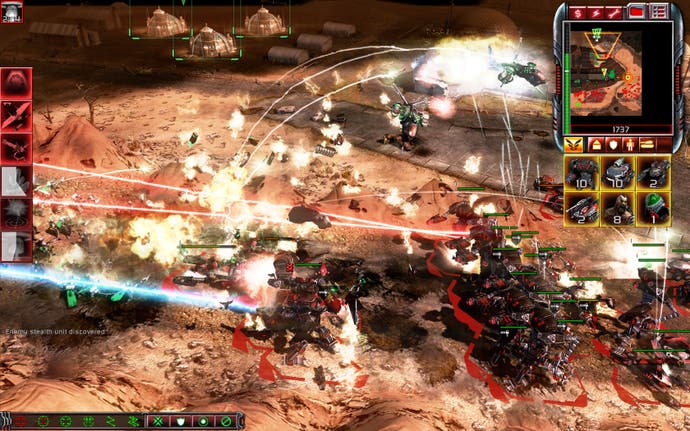Command & Conquer 3: Tiberium Wars
What, so the first two were just arguments?
Watching Sin City last year, I spent the first twenty minutes or so picking it apart in my head, worrying about how hollow it all felt, how nothingy a piece of film-making it was. And then a man torpedoed himself feet-first through the windshield of a moving car, and I had a moment of total clarity. I'm not supposed to take this remotely seriously, and I really, really shouldn't be thinking about it. This is purely hedonism. So, I just decided to go with it, and from thereon in a certain part of my mind was perfectly happy. The same happened with C&C3; the first few levels didn't make me feel anything. It was just there, the campy cut-scenes came and went, I was told exactly what to kill and where, and I kept feeling somewhat unsatisfied. I have done all this so very many times before, and a reasonably pretty 3D engine does nothing to change that.
Then, the inevitable lone assassin level. You know the drill - comb carefully around an enemy-filled map, and if she dies it's game over instantly. How terribly depressing. Except this lone assassin can kill forty men in less time than it takes me to blink. She's a one-woman genocide machine and, actually, it's hilarious. No longer creeping but now an unstoppable force laying waste to everything in sight, that was when I understood C&C3. It's not playing for laughs, as such, but it is playing for pure entertainment. The cheap-looking cut-scenes, featuring constant soap opera backstabbing and Sawyer from Lost mentioning male genitalia once too often, the total obviousness of how to win, the fact that a bunch of tiny men can somehow kill a towering alien tripod - don't worry about it. After the seriousness and amorality of Generals, C&C has identified what really makes it it. It's got the joke that its forerunners didn't even realise they were telling.
As such, it's very much the antidote to Supreme Commander. While that requires constant management, an iron will and the sort of brain that Oscar-winning films get made about, C&C 3 is really, really stupid. Well, in single-player at least - we've not been able to test the multiplayer yet, but we will bring you a full update on that very soon. (Goodness, didn't that sound all BBC News?) In the campaign though, you can afford to take your eye off the ball for long stretches, idly watching your latest rush of Scorpion Tanks rush do their thing, wondering if they'll manage to take out that sonic cannon before they're all destroyed, and not being hugely bothered if they don't. It's not that it's easy, but rather that you can take it easy. As long as every assault or defence contains something to deal with infantry, something to deal with vehicles and something to deal with planes, ideally in massed numbers, you're pretty much good to go.

That said, the odd level late in the campaigns can be a frustrating endurance test, relentlessly pushing enemies with suspiciously fast build speeds at you in staggered pincer movements until you finally manage to scrape together enough base defences to stage your own invasion. It's more awkward rather than truly taxing, though, a matter of time rather than skill you may or may not possess. Everything in the campaign is very carefully orchestrated, and sometimes the strings are a bit too obvious.
That aside, more so than ever before, this C&C is about entertaining rather than challenging. While on the surface very little has changed since its rather more tedious predecessor, Tiberium Sun, there's a subtle change to the mix. It's not really even trying to be a serious RTS - it just wants to live up to its name. You command, usually by drawing a big rectangle around everything on screen, and then you conquer, usually by then right-clicking on an enemy power station so their defences run out of juice and you can then kill everything else. Things explode prettily, the game announces that a few of your units have been promoted, and you feel like you've done something clever, even though you really haven't. Playing the Nod campaign on normal, I didn't run into anything seriously resembling trouble until the twilight levels. Even then it just took the one reload, now knowing I needed to place a few more Obelisks of light around my forward base while my messy handful of top-tier units waged war on the other side of the map. It's a fine balance between letting the player enjoy themselves and their feeling totally disengaged, but this just about hits it.

There is a strong chance it's a very different affair in multiplayer, where there aren't scripted assaults to look for ways around. Hopefully there the scattering of special abilities will come into play too. In single-player, there's a bunch of exciting-sounding upgrades and unit-pairing ultra-attacks, but after initially playing around with them, I just didn't bother any more, except as occasional extra spice to a battle I'd pretty much already won. They didn't seem to change the balance of war noticeably.
Neither do the much-vaunted new race, the alien Scrin, but that's actually to their favour. When you first encounter them, they seem like an infinite swarm of incomprehensible death, overwhelmingly different from the long-standing GDI and Nod factions. Next time you meet though, you get a brief chance to peek at their base, and it all starts making sense. Yep, that's a power generator, that's a barracks - they might have gossamer floaty bits and unearthly blue lights, but they're playing exactly to established C&C rules. Controlling them in skirmish mode felt awesome - I knew exactly what to do, but the knowing winks to War of the Worlds, Independence Day and just a touch of Starcraft's Zerg made the familiar so much more fun. The Scrin mothership might, essentially, have just the same effect as the Nod nuke or GDI Ion cannon, but the fact it's a gigantic ring of Death Starry destruction that makes ear-bleeding alien throbbing noises when you select it makes those Earthly armaments seem so conventional. The introduction of a third faction to an established roster could have failed horrifically, but the Scrin's implementation is really tight. They're the same, but different - contributing to what the makes C&C3 work, but also sealing its fate as a game that does things by the numbers.

While it's never going to leave a footprint on the history of RTS like its early ancestors did, I'm really hesitant to call C&C3's simplicity and dumbness a bad thing. It's simple and dumb because it wants to be, and has clearly worked very hard to be pretty watertight about it. While there's a certain obnoxiousness in its total refusal to innovate, in a lot of ways it's exactly the right real-time strategy game at exactly the right time. After years in the wilderness, RTS is pretty cool again right now, and something as cheerfully straightforward as this is just what's needed to stop the big braininess of Company of Heroes and Supreme Commander leading to another plunge into an inaccessibility that turns more casual players off the whole genre. On its own, it wouldn't work, but as an alternative, even a companion piece, to those it's a gentle success. This is the ying to their yang, the Question of Sport to their Have I Got News For You - it's pure trash, and it suits Command & Conquer through-and-through. Really, it has no right to try and be anything else, and it's because it knows this that it works so well.


